Characteristics of Carbonaceous Aerosol in PM2.5 at Wanzhou in the Southwest of China
Abstract
:1. Introduction
2. Measurements and Methodology
2.1. Experimental Site
2.2. Experimental Methods
3. Results and Discussion
3.1. Seasonal Variations of OC and EC in PM2.5
3.2. Diel Variations of OC and EC in PM2.5
3.3. Relationship between OC and EC
3.4. Estimation of Secondary Organic Carbon Concentration
3.5. Back Trajectory Analysis
4. Conclusions
Acknowledgments
Author Contributions
Conflicts of Interest
References
- Lim, H.J.; Turpin, B.J. Origins of primary and secondary organic aerosol in Atlanta: Results of time-resolved measurements during the Atlanta Supersite Experiment. Environ. Sci. Technol. 2002, 36, 4489–4496. [Google Scholar] [CrossRef] [PubMed]
- Cabada, J.C.; Pandis, S.N.; Subramanian, R.; Robinson, A.L.; Polidori, A.; Turpin, B. Estimating the secondary organic aerosol contribution to PM2.5 using the EC Tracer Method. Aerosol Sci. Technol. 2004, 38, 140–155. [Google Scholar] [CrossRef]
- Niu, Z.; Zhang, F.; Chen, J.; Yin, L.; Wang, S.; Xu, L. Carbonaceous species in PM2.5 in the coastal urban agglomeration in the Western Taiwan Strait Region, China. Atmos. Res. 2013, 122, 102–110. [Google Scholar] [CrossRef]
- Paraskevopoulou, D.; Liakakou, E.; Gerasopoulos, E.; Theodosi, C.; Mihalopoulos, N. Long-term characterization of organic and elemental carbon in the PM2.5 fraction: The case of Athens, Greece. Atmos. Chem. Phys. 2014, 14, 13313–13325. [Google Scholar] [CrossRef]
- Jacobson, M.Z. Strong radiative heating due to the mixing state of black carbon in atmospheric aerosols. Nature 2001, 409, 695–697. [Google Scholar] [CrossRef] [PubMed]
- Hansen, J.; Sato, M.; Ruedy, R.; Nazarenko, L.; Lacis, A.; Schmidt, G.A.; Russell, G.; Aleinov, I.; Bauer, M.; Bauer, S.; et al. Efficacy of climate forcings. J. Geophys. Res. 2005, 110, 2571–2592. [Google Scholar] [CrossRef]
- Pöschl, U. Atmospheric aerosols: Composition, transformation, climate and health effects. Angew. Chem. 2005, 44, 7520–7540. [Google Scholar] [CrossRef] [PubMed]
- Ramanathan, V.; Carmichael, G. Global and regional climate changes due to black carbon. Nat. Geosci. 2008, 1, 221–227. [Google Scholar] [CrossRef]
- Larson, S.M.; Cass, G.R. Characteristics of summer midday low-visibility events in the Los Angeles area. Environ. Sci. Technol. 1988, 23, 281–289. [Google Scholar] [CrossRef]
- Penner, J.E.; Eddleman, H.E.; Novakov, T. Towards the development of a global inventory for black carbon emissions. Atmos. Environ. Part A 1993, 27, 1277–1295. [Google Scholar] [CrossRef]
- Mauderly, J.L.; Chow, J.C. Health effects of organic aerosols. Inhal. Toxicol. 2008, 20, 257–288. [Google Scholar] [CrossRef] [PubMed]
- Huang, W.; Cao, J.; Tao, Y.; Dai, L.; Lu, S.E.; Hou, B.; Wang, Z.; Zhu, T. Seasonal variation of chemical species associated with short-term mortality effects of PM2.5 in Xi’an, a central city in China. Am. J. Epidemiol. 2012, 175, 556–566. [Google Scholar] [CrossRef] [PubMed]
- Cao, J.J.; Lee, S.C.; Ho, K.F.; Zhang, X.Y.; Zou, S.C.; Fung, K.; Chow, J.C.; Watson, J.G. Characteristics of carbonaceous aerosol in Pearl River Delta Region, China during 2001 winter period. Atmos. Environ. 2003, 37, 1451–1460. [Google Scholar] [CrossRef]
- Bae, M.; Schauer, J.J.; DeMinter, J.T.; Turner, J.R. Hourly and daily patterns of particle-phase organic and elemental carbon concentrations in the urban atmosphere. J. Air Waste Manag. Assoc. 2004, 54, 823–833. [Google Scholar] [CrossRef] [PubMed]
- Hand, J.L.; Schichtel, B.A.; Malm, W.C.; Frank, N.H. Spatial and temporal trends in PM2.5 organic and elemental carbon across the United States. Adv. Meteorol. 2013, 2013, 367674. [Google Scholar] [CrossRef]
- Vodička, P.; Schwarz, J.; Ždímal, V. Analysis of one year’s OC/EC data at a Prague suburban site with 2-h time resolution. Atmos. Environ. 2013, 77, 865–872. [Google Scholar] [CrossRef]
- Mancilla, Y.; Herckes, P.; Fraser, M.P.; Mendoza, A. Secondary organic aerosol contributions to PM2.5 in Monterrey, Mexico: Temporal and seasonal variation. Atmos. Res. 2015, 153, 348–359. [Google Scholar] [CrossRef]
- Streets, D.G.; Bond, T.C.; Carmichael, G.R.; Fernandes, S.D.; Fu, Q.; He, D.; Klimont, Z.; Nelson, S.M.; Tsai, N.Y.; Wang, M.Q.; et al. An inventory of gaseous and primary aerosol emissions in Asia in the year 2000. J. Geophys. Res. Atmos. 2003, 108. [Google Scholar] [CrossRef]
- Simpson, D.; Yttri, K.E.; Klimont, Z.; Kupiainen, K.; Caseiro, A.; Gelencsér, A.; Pio, C.; Puxbaum, H.; Legrand, M. Modeling carbonaceous aerosol over Europe: Analysis of the CARBOSOL and EMEP EC/OC campaigns. J. Geophys. Res. Atmos. 2007, 112. [Google Scholar] [CrossRef]
- Junker, C.; Liousse, C. A global emission inventory of carbonaceous aerosol from historic records of fossil fuel and biofuel consumption for the period 1860–1997. Atmos. Chem. Phys. 2008, 8, 1195–1207. [Google Scholar] [CrossRef]
- Chow, J.C.; Watson, J.G.; Lowenthal, D.H.; Chen, L.W.A.; Motallebi, N. PM2.5 source profiles for black and organic carbon emission inventories. Atmos. Environ. 2011, 45, 5407–5414. [Google Scholar] [CrossRef]
- López-Veneroni, D. The stable carbon isotope composition of PM2.5 and PM10 in Mexico City Metropolitan Area air. Atmos. Environ. 2009, 43, 4491–4502. [Google Scholar] [CrossRef]
- Cao, J.J.; Zhu, C.S.; Tie, X.X.; Geng, F.H.; Xu, H.M.; Ho, S.S.H.; Wang, G.H.; Han, Y.M.; Ho, K.F. Characteristics and sources of carbonaceous aerosols from Shanghai, China. Atmos. Chem. Phys. Discuss. 2012, 12, 16811–16849. [Google Scholar] [CrossRef]
- Han, Z.; Zhang, R.; Wang, Q.G.; Wang, W.; Cao, J.; Xu, J. Regional modeling of organic aerosols over China in summertime. J. Geophys. Res. 2008, 113. [Google Scholar] [CrossRef]
- Mahmud, A.; Barsanti, K.C. Improving the representation of secondary organic aerosol (SOA) in the MOZART-4 global chemical transport model. Geosci. Model Dev. Discuss. 2012, 5, 4187–4232. [Google Scholar] [CrossRef]
- Lin, P.; Hu, M.; Deng, Z.; Slanina, J.; Han, S.; Kondo, Y.; Takegawa, N.; Miyazaki, Y.; Zhao, Y.; Sugimoto, N. Seasonal and diurnal variations of organic carbon in PM2.5 in Beijing and the estimation of secondary organic carbon. J. Geophys. Res. 2009, 114. [Google Scholar] [CrossRef]
- Yang, F.; He, K.; Ye, B.; Chen, X.; Cha, L.; Cadle, S.H.; Chan, T.; Mulawa, P.A. One-year record of organic and elemental carbon in fine particles in downtown Beijing and Shanghai. Atmos. Chem. Phys. 2005, 5, 1449–1457. [Google Scholar] [CrossRef]
- Cao, J.J.; Lee, S.C.; Chow, J.C.; Watson, J.G.; Ho, K.F.; Zhang, R.J.; Jin, Z.D.; Shen, Z.X.; Chen, G.C.; Kang, Y.M.; et al. Spatial and seasonal distributions of carbonaceous aerosols over China. J. Geophys. Res. 2007, 112. [Google Scholar] [CrossRef]
- Zhang, R.J.; Cao, J.J.; Lee, S.C.; Shen, Z.X.; Ho, K.F. Carbonaceous aerosols in PM10 and pollution gases in winter in Beijing. J. Environ. Sci. 2007, 19, 564–571. [Google Scholar] [CrossRef]
- Li, W.F.; Bai, Z.P. Characteristics of organic and elemental carbon in atmospheric fine particles in Tianjin, China. Particuology 2009, 7, 432–437. [Google Scholar] [CrossRef]
- Zhao, P.S.; Dong, F.; Yang, Y.D.; He, D.; Zhao, X.J.; Zhang, W.Z.; Yao, Q.; Liu, H.Y. Characteristics of carbonaceous aerosol in the region of Beijing, Tianjin, and Hebei, China. Atmos. Environ. 2013, 71, 389–398. [Google Scholar] [CrossRef]
- Cao, J.J.; Lee, S.C.; Ho, K.F.; Zou, S.C.; Fung, K.; Li, Y.; Watson, J.G.; Chow, J.C. Spatial and seasonal variations of atmospheric organic carbon and elemental carbon in Pearl River Delta Region, China. Atmos. Environ. 2004, 38, 4447–4456. [Google Scholar] [CrossRef]
- Duan, J.C.; Tan, J.H.; Cheng, D.X.; Bi, X.H.; Deng, W.J.; Sheng, G.Y.; Fu, J.M.; Wong, M.H. Sources and characteristics of carbonaceous aerosol in two largest cities in Pearl River Delta Region, China. Atmos. Environ. 2007, 41, 2895–2903. [Google Scholar] [CrossRef]
- Feng, Y.; Chen, Y.; Guo, H.; Zhi, G.; Xiong, S.; Li, J.; Sheng, G.; Fu, J. Characteristics of organic and elemental carbon in PM2.5 samples in Shanghai, China. Atmos. Res. 2009, 92, 434–442. [Google Scholar] [CrossRef]
- Pathak, R.K.; Wang, T.; Ho, K.F.; Lee, S.C. Characteristics of summertime PM2.5 organic and elemental carbon in four major Chinese cities: Implications of high acidity for water-soluble organic carbon (WSOC). Atmos. Environ. 2011, 45, 318–325. [Google Scholar] [CrossRef]
- Cao, J.J.; Wu, F.; Chow, J.C.; Lee, S.C.; Li, Y.; Chen, S.W.; An, Z.S.; Fung, K.K.; Watson, J.G.; Zhu, C.S.; et al. Characterization and source apportionment of atmospheric organic and elemental carbon during fall and winter of 2003 in Xi’an, China. Atmos. Chem. Phys. 2005, 5, 3127–3137. [Google Scholar] [CrossRef]
- Zhang, L.; Huang, Y.; Liu, Y.; Yang, F.; Lan, G.; Fu, C.; Wang, J. Characteristics of carbonaceous species in PM2.5 in Wanzhou in the hinterland of the Three Gorges Reservior of northeast Chongqing, China. Atmosphere 2015, 6, 534–546. [Google Scholar] [CrossRef]
- Peng, C.; Zhai, C.Z.; Wang, H.B.; Tian, M.; Li, H.L.; Liu, Y.; Fu, C.; Zhang, L.Y.; Yang, F.M. Characterization of organic carbon and elemental carbon in PM2.5 in the urban Wanzhou area in summer and winter. Acta Sci. Circumatantiae 2015, 35, 1638–1644. (In Chinese) [Google Scholar]
- Turpin, B.J.; Saxena, P.; Andrews, E. Measuring and simulating particulate organics in the atmosphere: Problems and prospects. Atmos. Environ. 2000, 34, 2983–3013. [Google Scholar] [CrossRef]
- Birch, M.E. Analysis of carbonaceous aerosols: Interlaboratory comparison. Analyst 1998, 123, 851–857. [Google Scholar] [CrossRef] [PubMed]
- Polidori, A.; Turpin, B.J.; Lim, H.J.; Cabada, J.C.; Subramanian, R.; Pandis, S.N.; Robinson, A.L. Local and regional secondary organic aerosol: Insights from a year of semi-continuous carbon measurements at Pittsburgh. Aerosol Sci. Technol. 2006, 40, 861–872. [Google Scholar] [CrossRef]
- Duan, F.K.; He, K.B.; Ma, Y.L.; Jia, Y.T.; Yang, F.M.; Lei, Y.; Tanaka, S.; Okuta, T. Characteristics of carbonaceous aerosols in Beijing, China. Chemosphere 2005, 60, 355–364. [Google Scholar] [CrossRef] [PubMed]
- Wu, C.; Ng, W.M.; Huang, J.; Wu, D.; Yu, J.Z. Determination of elemental and organic carbon in PM2.5 in the Pearl River Delta Region: Inter-instrument (Sunset vs. DRI Model 2001 Thermal/Optical Carbon Analyzer) and inter-protocol comparisons (IMPROVE vs. ACE-Asia Protocol). Aerosol Sci. Technol. 2012, 46, 610–621. [Google Scholar] [CrossRef]
- Yttri, K.E.; Aas, W.; Bjerke, A.; Cape, J.N.; Cavalli, F.; Ceburnis, D.; Dye, C.; Emblico, L.; Facchini, M.C.; Forster, C. Elemental and organic carbon in PM10: A one year measurement campaign within the European Monitoring and Evaluation Programme EMEP. Atmos. Chem. Phys. 2007, 7, 5711–5725. [Google Scholar] [CrossRef]
- Turpin, B.J.; Lim, H.J. Species contributions to PM2.5 mass concentrations: Revisiting common assumptions for estimating organic mass. Aerosol Sci. Technol. 2001, 35, 602–610. [Google Scholar] [CrossRef]
- Yang, F.; Tan, J.; Zhao, Q.; Du, Z.; He, K.; Ma, Y.; Duan, F.; Chen, G.; Zhao, Q. Characteristics of PM2.5 speciation in representative megacities and across China. Atmos. Chem. Phys. 2011, 11, 5207–5219. [Google Scholar] [CrossRef]
- Chow, J.C.; Watson, J.G.; Chen, L.W.A.; Ho, S.S.H.; Koracin, D.; Zielinska, B.; Tang, D.; Perera, F.; Cao, J.; Lee, S.C. Exposure to PM2.5 and PAHs from the Tong Liang, China Epidemiological Study. J. Environ. Sci. Health Part A 2006, 41, 517–542. [Google Scholar] [CrossRef]
- Tao, J.; Cheng, T.; Zhang, R.; Cao, J.; Zhu, L.; Wang, Q.; Luo, L.; Zhang, L. Chemical composition of PM2.5 at an urban site of Chengdu in southwestern China. Adv. Atmos. Sci. 2013, 30, 1070–1084. [Google Scholar] [CrossRef]
- Cheng, H.R.; Wang, Z.W.; Feng, J.L.; Chen, H.L.; Zhang, F.; Liu, J. Carbonaceous species composition and source apportionment of PM2.5 in urban atmosphere of Wuhan. Ecol. Environ. Sci. 2012, 21, 1574–1579. (In Chinese) [Google Scholar]
- Zhang, F.W.; Zhao, J.P.; Chen, J.S.; Xu, Y.; Xu, L. Pollution characteristics of organic and elemental carbon in PM2.5 in Xiamen, China. J. Environ. Sci. 2011, 23, 1342–1349. [Google Scholar] [CrossRef]
- Zhao, L.; Lu, Q.M.; Li, L.; Luo, Y.Z.; Yang, Q.L.; Chen, G.C. Chemical characteristics of atmospheric precipitation at Wanzhou district of Chongqing. Environ. Ecol. Three Gorges 2013, 35, 9–15. (In Chinese) [Google Scholar]
- Turpin, B.J.; Huntzicker, J.J. Secondary formation of organic aerosol in the Los Angeles basin: A descriptive analysis of organic and elemental carbon concentrations. Atmos. Environ. 1991, 25, 207–215. [Google Scholar] [CrossRef]
- Chow, J.C.; Watson, J.G.; Lu, Z.; Lowenthal, D.H.; Frazier, C.A.; Solomon, P.A.; Thuillier, R.H.; Magliano, K. Descriptive analysis of PM2.5, and PM10, at regionally representative locations during SJVAQS/AUSPEX. Atmos. Environ. 1996, 30, 2079–2112. [Google Scholar] [CrossRef]
- Schauer, J.J.; Kleeman, M.J.; Cass, G.R.; Simoneit, B.R. Measurement of emissions from air pollution sources. 5. C1–C32 organic compounds from gasoline-powered motor vehicles. Environ. Sci. Technol. 2002, 36, 1169–1180. [Google Scholar] [CrossRef] [PubMed]
- Chen, Y.; Zhi, G.; Feng, Y.; Fu, J.; Feng, J.; Sheng, G.; Simoneit, B.R.T. Measurements of emission factors for primary carbonaceous particles from residential raw-coal combustion in China. Geophys. Res. Lett. 2006, 33, 382–385. [Google Scholar] [CrossRef]
- Schauer, J.J.; Kleeman, M.J.; Cass, G.R.; Simoneit, B.R. Measurement of emissions from air pollution sources. 3. C1–C29 organic compounds from fireplace combustion of wood. Environ. Sci. Technol. 2001, 35, 1716–1728. [Google Scholar] [CrossRef] [PubMed]
- He, L.; Hu, M.; Huang, X.; Yu, B.; Zhang, Y.; Liu, D. Measurement of emissions of fine particulate organic matter from Chinese cooking. Atmos. Environ. 2004, 38, 6557–6564. [Google Scholar] [CrossRef]
- Watson, J.G.; Chow, J.C.; Houck, J.E. PM2.5 chemical source profiles for vehicle exhaust, vegetative burning, geological material, and coal burning in Northwestern Colorado during 1995. Chemosphere 2001, 43, 1141–1151. [Google Scholar] [CrossRef]
- Strader, R.; Lurmann, F.; Pandis, S.N. Evaluation of secondary organic aerosol formation in winter. Atmos. Environ. 1999, 33, 4849–4863. [Google Scholar] [CrossRef]
- Appel, B.R.; Colodny, P.; Wesolowski, J.J. Analysis of carbonaceous materials in southern California atmospheric aerosols. Environ. Sci. Technol. 1976, 13, 98–104. [Google Scholar] [CrossRef]
- Castro, L.M.; Pio, C.A.; Harrison, R.M.; Smith, D.J.T. Carbonaceous aerosol in urban and rural European atmospheres: Estimation of secondary organic carbon concentrations. Atmos. Environ. 1999, 33, 2771–2781. [Google Scholar] [CrossRef]
- Wang, Y.Q.; Zhang, X.Y.; Draxler, R.R. TrajStat: GIS-based software that uses various trajectory statistical analysis methods to identify potential sources from long-term air pollution measurement data. Environ. Model. Softw. 2009, 24, 938–939. [Google Scholar] [CrossRef]
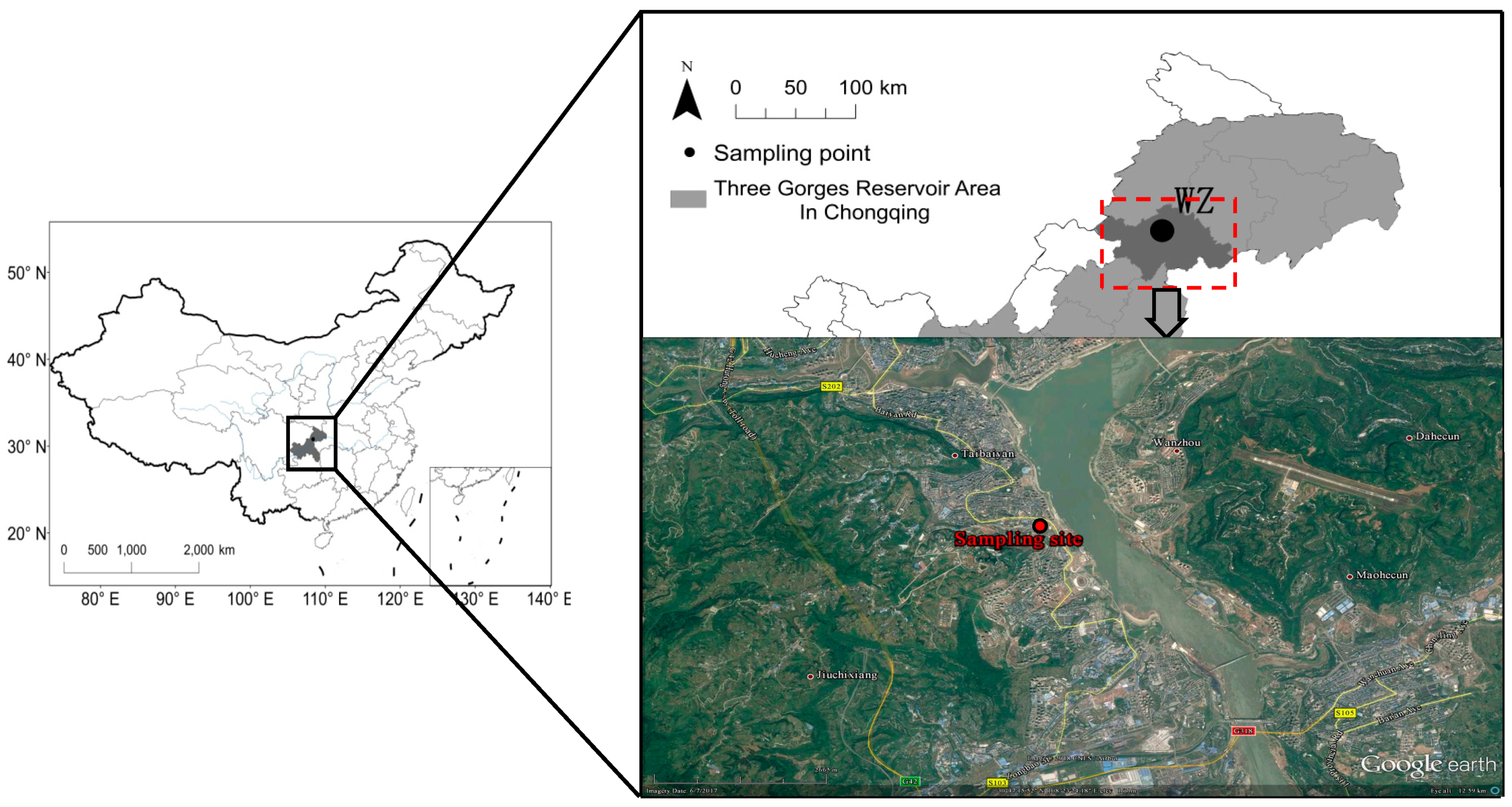
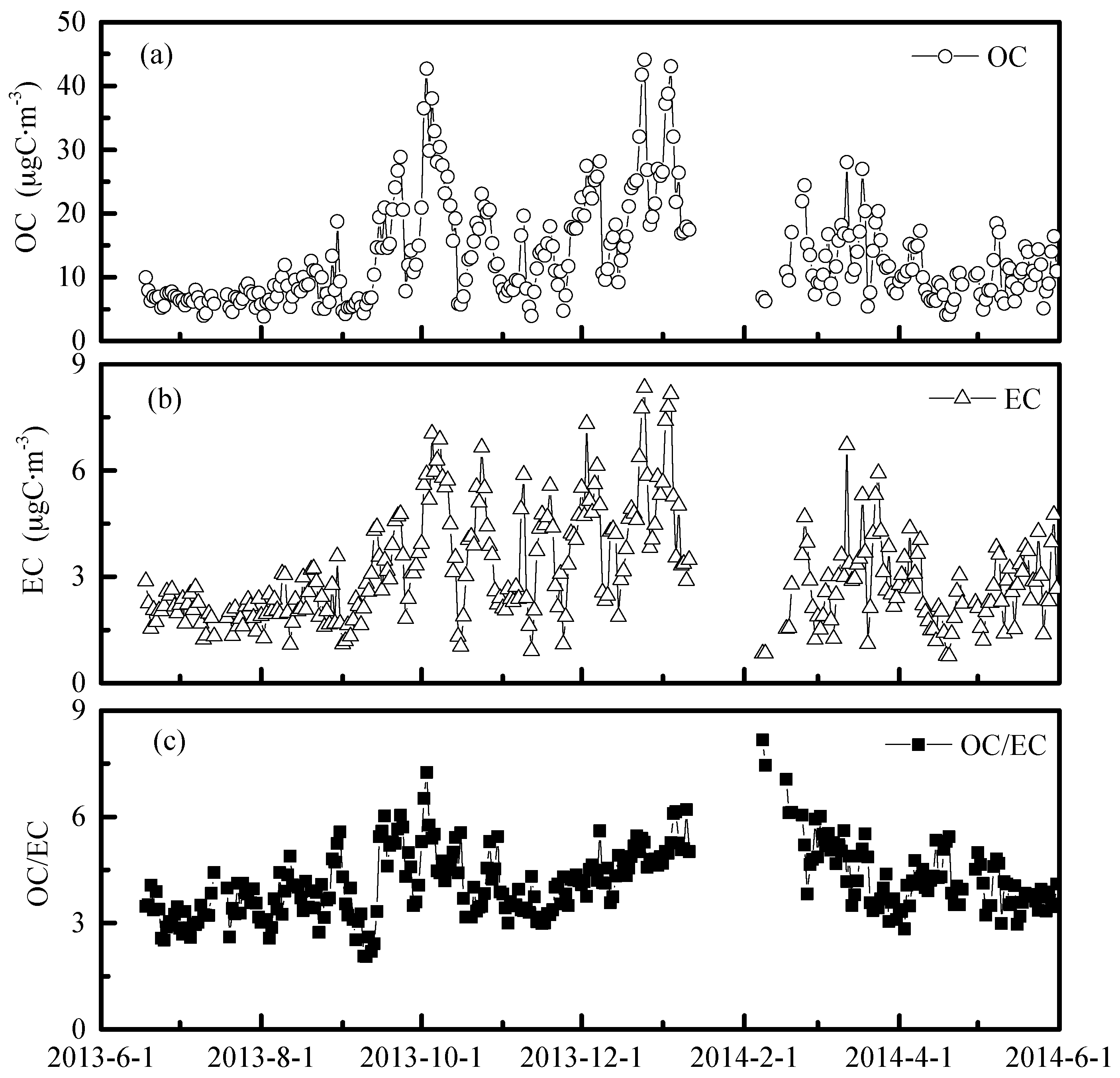
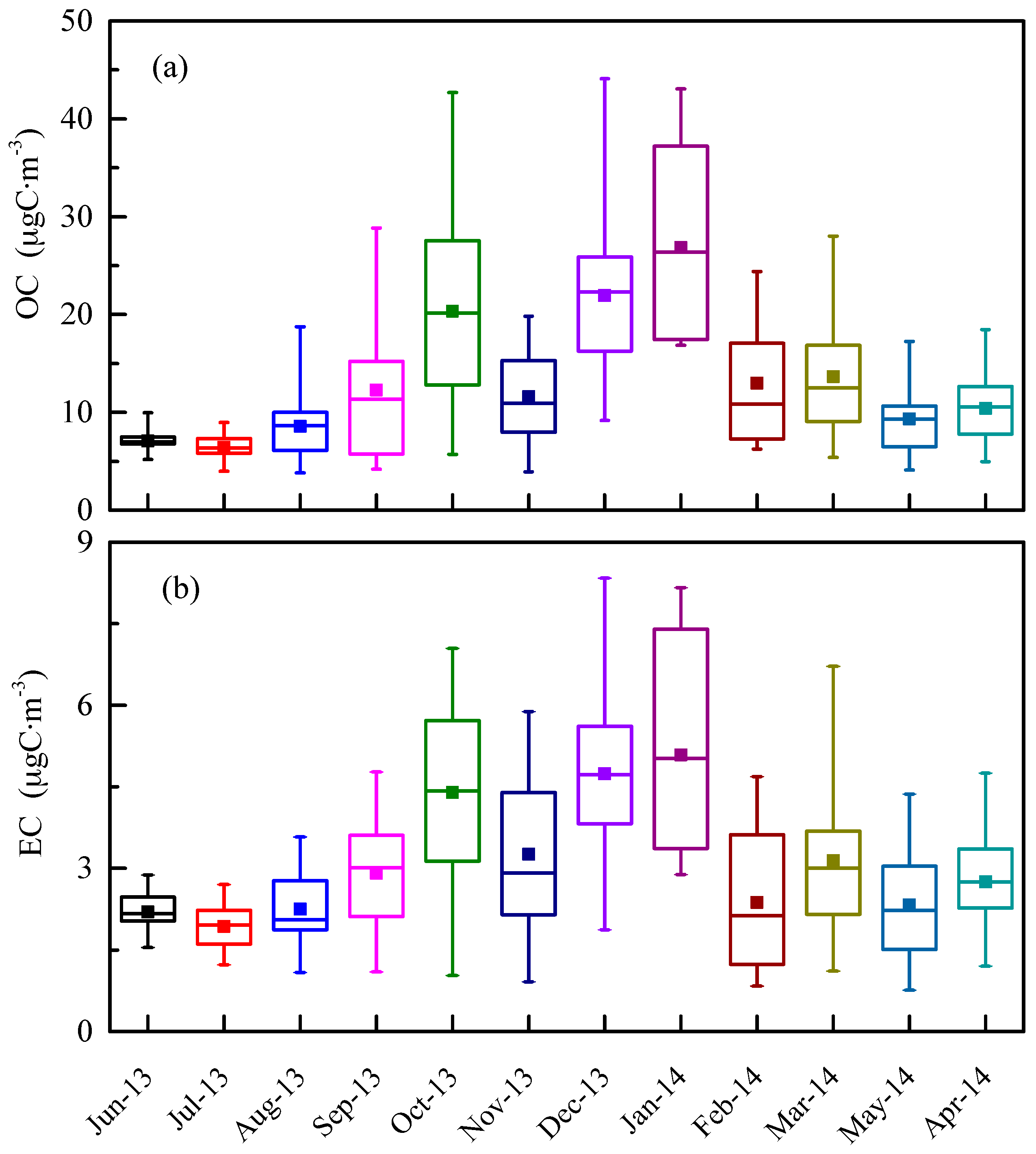
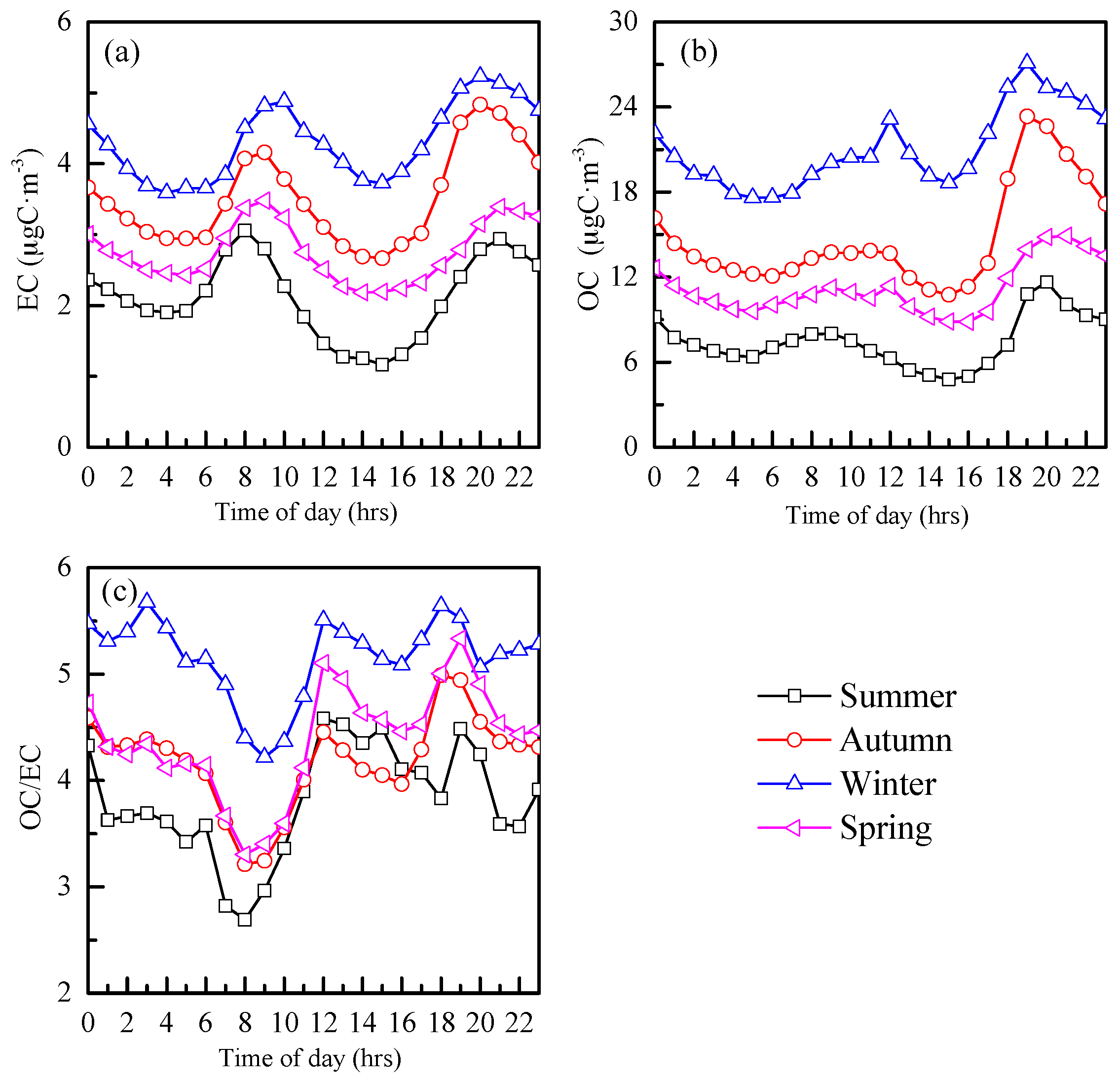
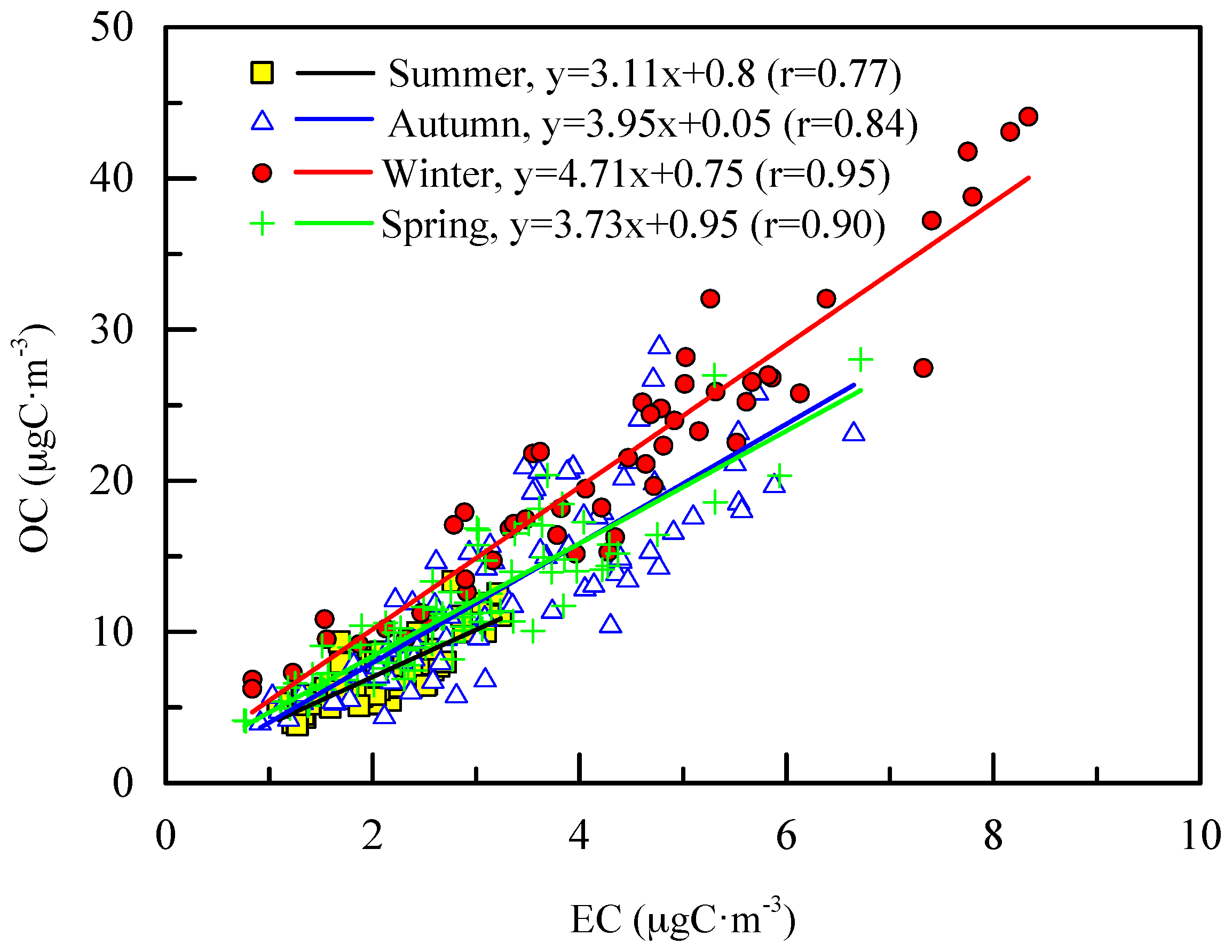
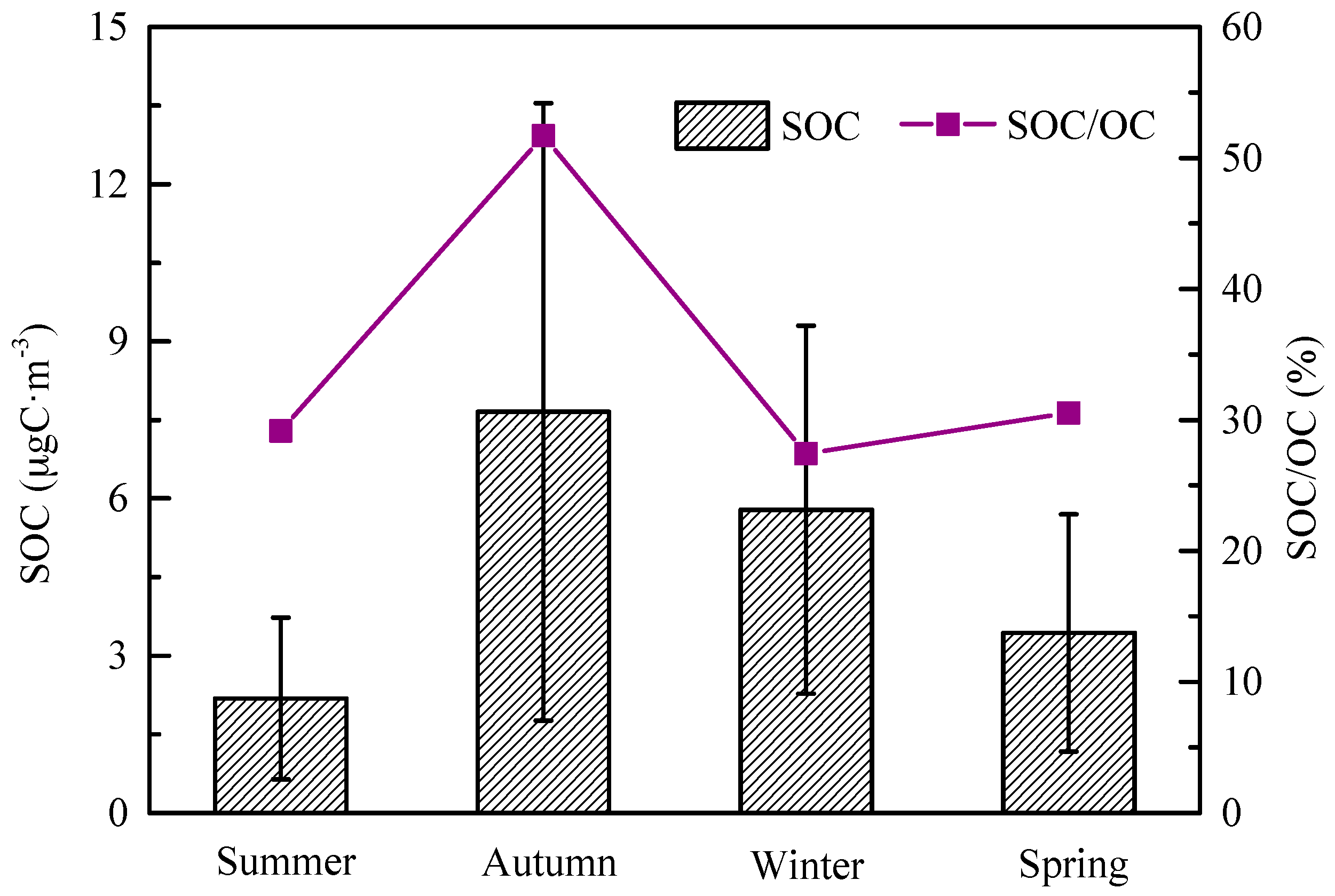
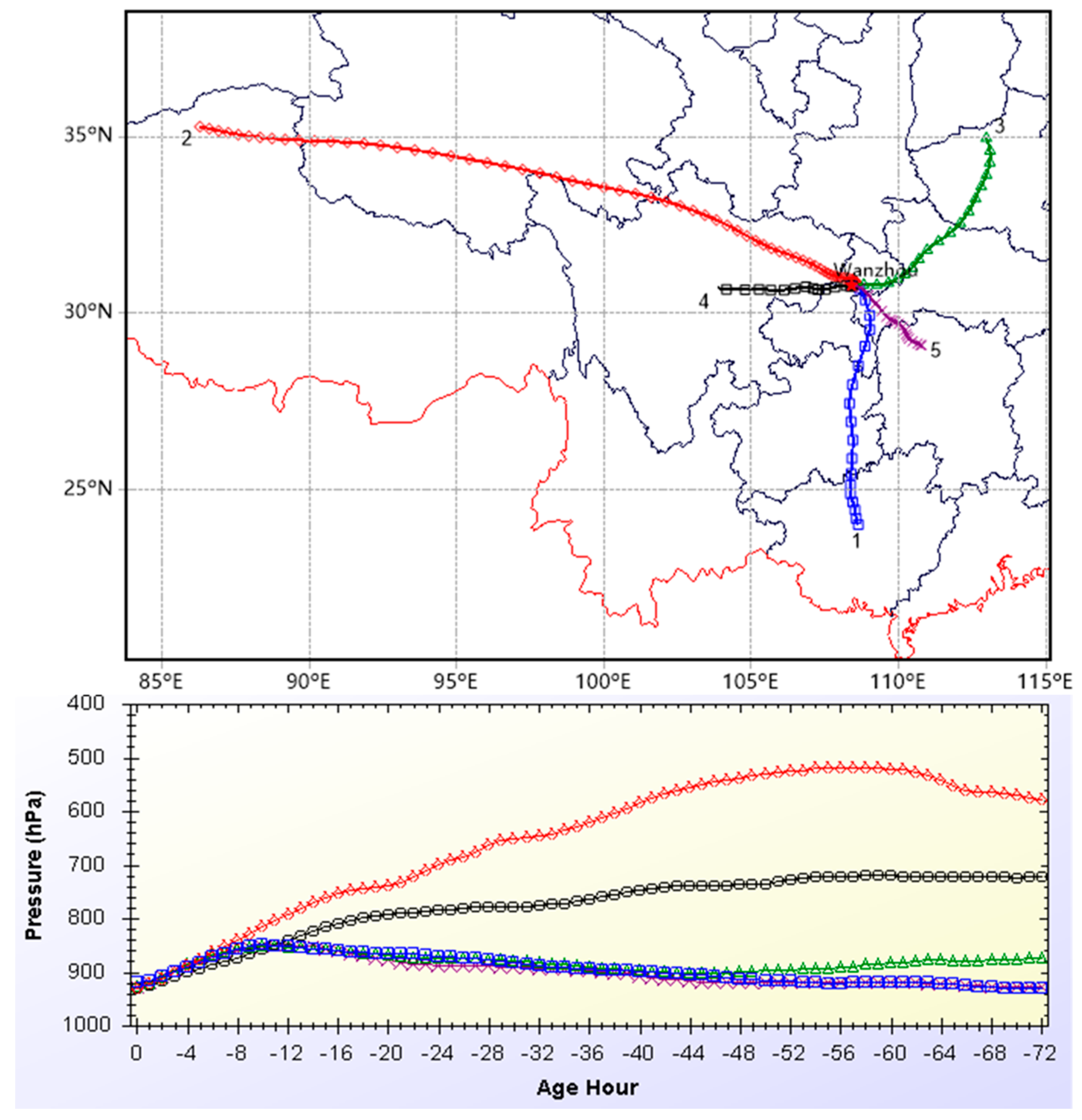
| Locations | Sampling Period | OC | EC | TC/PM2.5 | TCA/PM2.5 | OC & EC Method | Reference |
|---|---|---|---|---|---|---|---|
| Wanzhou | 18 June 2013–31 May 2014 | 13.16 | 3.12 | 25.6% | 38% | TOT | This study |
| Downtown Chongqing | March 2005–February 2006 | 30.13 | 6.39 | 28.3% | 42.3% | TOR | [46] |
| Tongliang, Chongqing | 2 March 2002–26 February 2003 | 36.9 | 10.7 | 41.1% | 51.3% | TOR | [47] |
| Chengdu | 19 April 2009–31 January 2010 | 22.3 | 9.0 | 19% | 32% | TOR | [48] |
| Tianjin | January, April, July 2007 | 22.7 | 5.1 | 23.9% | 35% | TOR | [30] |
| Beijing | April 2009–February 2010 | 18.2 | 6.3 | 19.8% | 28.7% | TOR | [31] |
| Fuze District, Quanzhou | November 2010–August 2011 | 13.5 | 2.4 | 18.9% | 28.5% | TOT | [3] |
| Guangzhou | 16 August–17 September 2004; | 17.5 | 5.7 | 21.6% | 32% | TOT | [33] |
| 1 Februry–8 March 2005 | 23.9 | 4.4 | 21.8% | 32.9% | |||
| Shanghai | October 2005; January, April, July 2006 | 14.7 | 2.8 | 19.4% | 28.9% | TOT | [34] |
| Wuhan | July 2011–February 2012 | 19.4 | 2.9 | 17.6% | 26.7% | TOT | [49] |
| Jimei, Xiamen | April 2009–January 2010 | 15.8 | 2.7 | 28.9% | 42.8% | TOT | [50] |
| Summer | Autumn | Winter | Spring | |
|---|---|---|---|---|
| OC/(μgC·m−3) | 7.49 ± 2.37 | 14.81 ± 8.39 | 21.11 ± 9.22 | 11.25 ± 4.65 |
| EC/(μgC·m−3) | 2.12 ± 0.51 | 3.53 ± 1.51 | 4.32 ± 1.86 | 2.76 ± 1.12 |
| OC/EC | 3.55 ± 0.64 | 4.09 ± 1.04 | 5.03 ± 0.91 | 4.15 ± 0.74 |
| Temperature/(°C) | 29.7 ± 2.5 | 18.9 ± 4.6 | 8.7 ± 2.2 | 17.7 ± 3.7 |
| Relative Humidity/(%) | 69.2 ± 12.9 | 80.6 ± 12.1 | 78.0 ± 11.5 | 80.2 ± 10.7 |
| Wind Speed/(m·s−1) | 0.95 ± 0.33 | 0.79 ± 0.17 | 0.78 ± 0.24 | 0.84 ± 0.25 |
| Cluster | Number | Percent of Total Trajectories | Mean Concentration (μg·m−3) | |||
|---|---|---|---|---|---|---|
| PM2.5 | OC | EC | TC | |||
| 1 | 37 | 12.2% | 48.46 | 7.18 | 2.13 | 9.31 |
| 2 | 27 | 8.9% | 76.70 | 14.74 | 3.53 | 18.25 |
| 3 | 63 | 20.8% | 42.58 | 10.02 | 2.34 | 12.36 |
| 4 | 59 | 19.5% | 86.69 | 17.09 | 4.23 | 21.31 |
| 5 | 117 | 38.6% | 65.65 | 14.39 | 3.19 | 17.57 |
© 2018 by the authors. Licensee MDPI, Basel, Switzerland. This article is an open access article distributed under the terms and conditions of the Creative Commons Attribution (CC BY) license (http://creativecommons.org/licenses/by/4.0/).
Share and Cite
Huang, Y.; Liu, Y.; Zhang, L.; Peng, C.; Yang, F. Characteristics of Carbonaceous Aerosol in PM2.5 at Wanzhou in the Southwest of China. Atmosphere 2018, 9, 37. https://doi.org/10.3390/atmos9020037
Huang Y, Liu Y, Zhang L, Peng C, Yang F. Characteristics of Carbonaceous Aerosol in PM2.5 at Wanzhou in the Southwest of China. Atmosphere. 2018; 9(2):37. https://doi.org/10.3390/atmos9020037
Chicago/Turabian StyleHuang, Yimin, Yuan Liu, Liuyi Zhang, Chao Peng, and Fumo Yang. 2018. "Characteristics of Carbonaceous Aerosol in PM2.5 at Wanzhou in the Southwest of China" Atmosphere 9, no. 2: 37. https://doi.org/10.3390/atmos9020037
APA StyleHuang, Y., Liu, Y., Zhang, L., Peng, C., & Yang, F. (2018). Characteristics of Carbonaceous Aerosol in PM2.5 at Wanzhou in the Southwest of China. Atmosphere, 9(2), 37. https://doi.org/10.3390/atmos9020037




